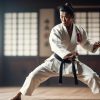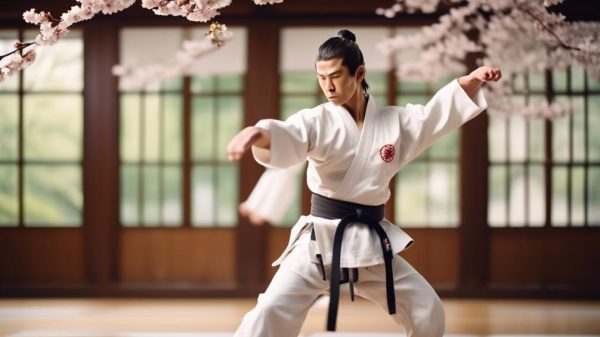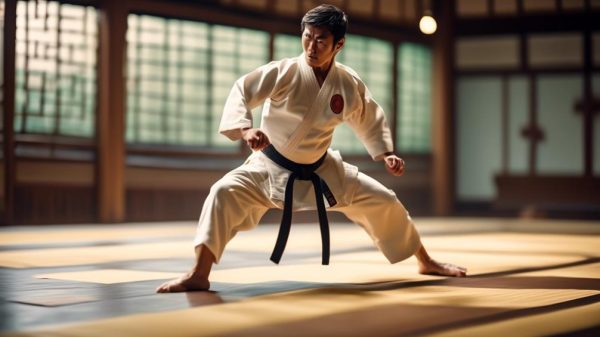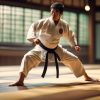Ready to tap into your inner strength and uncover the secrets of Goju-Ryu stances?
Get ready to explore the dynamic world of martial arts and harness the power within you.
In this article, we’ll dive into the foundation of Goju-Ryu Karate, exploring how key stances can empower you with stability, strength, and precision.
Whether you’re new to martial arts or an experienced practitioner striving for perfection, mastering these stances is essential.
Through detailed insights, you’ll learn how Sanchin Dachi, Zenkutsu Dachi, Kokutsu Dachi, Kiba Dachi, and Neko Ashi Dachi can enhance your martial arts skills.
It’s time to embrace unshakable stability and unlock your full potential with the empowering Goju-Ryu stances.
Key Takeaways
“Goju-Ryu stances provide a strong foundation for martial arts practitioners, offering stability, strength, and precision.
By mastering these stances, you can enhance your skills and tap into your inner power. Whether you’re a beginner or an experienced martial artist, understanding the importance of Sanchin Dachi, Zenkutsu Dachi, Kokutsu Dachi, Kiba Dachi, and Neko Ashi Dachi is crucial.
These stances not only provide a solid base for your techniques but also improve your balance, focus, and overall performance.
By incorporating these stances into your training, you can elevate your martial arts journey to new heights.”
Sanchin Dachi (Hour Glass Stance)
Mastering the Sanchin Dachi stance in Goju-Ryu Karate is essential for building a strong foundation in your martial arts practice.
The Hour Glass Stance is more than just a stance; it forms the bedrock of power and defense.
To fully unlock its potential, focus on Sanchin Dachi training techniques that prioritize stability, strength, and proper body alignment.
This stance goes beyond physicality; it hones your mental resilience, preparing you for any challenge that may arise.
Sanchin Dachi is not merely a stationary position; it represents a dynamic state of readiness, a testament to your preparedness to confront any situation.
Embrace it for self-defense, as it offers a sturdy platform from which to launch powerful strikes and absorb impact.
With Sanchin Dachi, you embody strength, balance, and an unwavering spirit of liberation.
Zenkutsu Dachi (Front Stance)
The Zenkutsu Dachi, also known as the Front Stance, is a fundamental position in Goju-Ryu Karate.
It provides stability and power for executing strong strikes and maintaining balance.
When transitioning from the Hour Glass Stance to the Zenkutsu Dachi, you’ll notice that the emphasis on stability and body alignment remains, allowing you to enhance your martial arts skills.
Proper alignment in the Zenkutsu Dachi is essential for generating maximum power in strikes and maintaining a strong defense.
This stance is highly effective in self-defense scenarios, enabling you to deliver powerful kicks and punches while staying grounded.
In practical applications, the Zenkutsu Dachi allows you to deliver decisive blows and quickly assume defensive positions, making it a crucial stance for self-defense purposes.
Kokutsu Dachi (Back Stance)
To improve your stability and power in martial arts, incorporating the Kokutsu Dachi (Back Stance) is essential.
This foundational position provides a solid base for defense and counterattacks.
Here are some important considerations when using Kokutsu Dachi:
- Practical Application in Self Defense: Kokutsu Dachi allows you to maximize reach and power during counterattacks, making it highly effective for defending against opponents.
- Common Mistakes to Avoid: It’s crucial to maintain proper balance and stability by avoiding excessive leaning backward. Additionally, ensure that your back knee is not locked, as this can limit mobility and effectiveness.
Kiba Dachi (Horse Stance)
If you want to improve your stability and leg strength in Goju-Ryu Karate, incorporating Kiba Dachi (Horse Stance) is crucial.
Kiba Dachi is a wide and deep stance that positions your feet wider than shoulder-width apart.
By bending your knees deeply, you create a squat-like position that evenly distributes your weight between both legs, promoting stability and balance in Kiba Dachi.
This stance is excellent for strengthening the lower body, as the deep knee bend engages your quadriceps, hamstrings, and glutes, promoting overall leg strength.
By adding Kiba Dachi to your training, you’ll not only improve stability and balance but also strengthen your lower body, providing a solid foundation for powerful techniques and movements in Goju-Ryu Karate.
Neko Ashi Dachi (Cat Stance)
Mastering the narrow and light stance of Neko Ashi Dachi in Goju-Ryu Karate is essential for your martial arts skills.
Also known as the Cat Stance, it offers quick and evasive movements, making it perfect for dodging attacks and executing counter-strikes.
Here are some techniques and drills to improve your cat stance:
- Applications in Martial Arts: Utilize Neko Ashi Dachi for swift and evasive movements, enhancing your ability to dodge attacks and counter effectively.
- Weight Distribution Drill: Practice shifting your weight smoothly from the back leg to the front leg. Keep the front foot slightly raised throughout the movement for proper balance.
- Balance and Stability Exercise: Strengthen your stabilizing muscles by practicing one-legged stances. This will improve your overall balance and agility in Neko Ashi Dachi.
- Agility Training: Incorporate speed and agility drills into your training to enhance your ability to transition in and out of the Cat Stance quickly during combat scenarios.
Stance Characteristics and Benefits
Understanding the characteristics and benefits of each stance in Goju-Ryu Karate is essential for enhancing your martial arts performance.
The proper stances not only provide stability and power but also foster agility and speed.
Incorrect execution of stances can decrease their effectiveness and leave you vulnerable in combat.
By mastering the stances, you can optimize your body’s alignment, strength, and balance, unlocking your full potential as a martial artist.
Here is a summary of the benefits of each stance and the common mistakes to avoid:
- Sanchin Dachi: This stance offers stability, strength, and proper body alignment. One common mistake is allowing the knees to collapse inward.
- Zenkutsu Dachi: This stance is known for power in strikes and stability in movement. It’s important to avoid overextending the front knee beyond the toes.
- Kokutsu Dachi: This stance provides a strong base for defensive techniques. Be cautious of leaning the upper body too far forward.
- Kiba Dachi: This stance enhances leg strength and stability. Avoid allowing the knees to collapse inward.
- Neko Ashi Dachi: This stance enables quick and agile movements. It’s crucial not to place too much weight on the front leg.
Proper Execution and Alignment
Refining your stances in Goju-Ryu Karate is a continuous process that ensures proper execution and alignment.
To achieve maximum power generation and stability, it’s important to pay attention to the alignment techniques for each stance.
Here’s how you can achieve proper execution and alignment:
- Sanchin Dachi (Hour Glass Stance): Focus on maintaining a wide and stable base, with slightly inward-turned feet and an even distribution of weight.
- Zenkutsu Dachi (Front Stance): Keep the front leg bent, the back leg straight, and put most of the weight on the front leg for powerful strikes.
- Kokutsu Dachi (Back Stance): Make sure the back leg is bent, the front leg is straight, and the weight is predominantly on the back leg for a strong defensive base.
- Kiba Dachi (Horse Stance): Maintain a deep and wide stance with an even distribution of weight to improve leg strength and stability.
Applications in Karate Practice
Enhance your karate practice by effectively applying the Goju-Ryu stances. These stances play a crucial role in self-defense, providing power, stability, and balance during strikes and defensive moves.
One such stance is Sanchin Dachi, which serves as a solid foundation for delivering strong blows while maintaining stability.
For forward movements and striking techniques, Zenkutsu Dachi offers stability and strength.
When it comes to defensive maneuvers, Kokutsu Dachi is essential for maintaining a strong base.
To enhance leg strength and overall stability, Kiba Dachi is highly beneficial.
Additionally, Neko Ashi Dachi enables quick and agile movements for swift defensive actions.
By mastering the application of these stances, you can elevate your karate practice, executing each technique with precision and power.
Remember, the key to success lies in practicing and perfecting these stances for optimal performance.
Frequently Asked Questions
Are These Stances Only Used in Goju-Ryu Karate, or Are They Common in Other Martial Arts as Well?
Are these stances exclusive to Goju-Ryu Karate, or are they commonly used in other martial arts as well?
Stance applications go beyond Goju-Ryu and can be found in various martial arts, each with their own variations and training modifications designed for different combat techniques.
How Do These Stances Help Improve Overall Flexibility and Balance?
To improve flexibility, these stances involve deep knee bends that strengthen the muscles in your legs and increase your range of motion.
By focusing on how you distribute your weight and position your feet, these stances also enhance your balance and help you develop a strong and stable foundation.
Can These Stances Be Modified for Practitioners With Physical Limitations or Injuries?
Stances can be modified to accommodate practitioners with physical limitations or injuries.
Think of it as shaping clay – you can alter the depth or width of the stance to provide more stability, and adjust the distribution of weight to alleviate strain.
Flexibility is crucial when adapting stances to individual needs.
Are There Specific Breathing Techniques That Should Be Used in Conjunction With These Stances?
When practicing Goju-Ryu stances, it is beneficial to incorporate specific breathing techniques.
By focusing on controlled inhales and exhales, you can enhance your flexibility training and improve your stability.
Deep breaths can help align your body and improve your balance.
By combining these breathing techniques with your stances, you can unleash your power and maximize the benefits of your practice.
How Do These Stances Translate Into Practical Self-Defense Situations Outside of the Dojo?
In practical self-defense situations outside of the dojo, the stances from Goju-Ryu Karate have real-world applications.
Kiba Dachi’s low and stable position provides a strong foundation for maintaining balance and delivering powerful strikes.
On the other hand, Neko Ashi Dachi allows for agile movements and unconventional techniques, enabling practitioners to adapt and react quickly in unpredictable street encounters.
These stances, when applied effectively, can enhance one’s ability to defend oneself in real-life scenarios.









